Ecuador isn’t often in the headlines because of its art and cultural heritage. Most recent news on Ecuador has been about gang activity and the endemic violence that has struck a serious blow to Ecuador’s reputation as a laissez-faire retirement haven for U.S. seniors. Ecuador has long been thought of as one of the safest South American countries. However, its US dollar economy, its proximity to major drug cartels in Colombia and their money-laundering activities, and a series of internal political crises culminated in a serious social breakdown in January 2024. Criminal activity flourished with looting of stores and eruptions of violence, extortion and threats against the public.

State television broadcast taken over by armed gang, January 9, 2024.
In January 2024, Ecuadorans watching the news instead saw a takeover of the main state television studio, as gang members in balaclavas put guns to the heads of anchors and staff. Also in January, riots in response to the escape of a notorious gang leader left 125 guards and 14 administrative staff held hostage in prisons across the country while massacres of inmates by opposing gangs took place. At least four candidates in the most recent presidential and mayoral elections were assassinated by gangs. Ecuador’s murder rate is now the highest in the Western Hemisphere. However, a government crackdown was able to end Ecuador’s official State of Emergency in April, and police and the military have restored quiet to most areas.
It is noteworthy that none of this violence had anything to do with antiquities or art. Drug lords and their gangs and other criminals aren’t interested in low value, hard to sell goods like antiquities.
State Department Goals Contradict the Law it is Supposed to be Administering

Ceramic, marked “taken out of the cavern in Quito”, Musée Carnavalet, Histoire de Paris. CCP 1.0 Universal Public Domain Dedication.
Despite having all this on its plate, on June 4, 2024, the Republic of Ecuador asked the Cultural Property Advisory Committee (CPAC) at the U.S. State Dept to renew import restrictions blocking U.S. entry to a comprehensive list of 14,000 years of Ecuadorian art, antiquities, and ethnographic objects. Ecuador gave no explanation of the need for a continuing blockade, nor did it say how the country had met the requirements of the U.S. law governing such agreements. To be fair, Ecuador hadn’t explained why it needed export requirements 5 years earlier, when CPAC had granted the original request.[1] In executing that agreement in 2019, the State Dept. had violated the underlying U.S. law, the Cultural Property Implementation Act (CPIA), in three different ways;
- by failing to list specific items on import restrictions so importers would know how to abide by them,
- by restricting U.S. import to whatever objects didn’t possess an Ecuadorian export permit[2], when U.S. law allows import of objects that left Ecuador “not less than ten years before the date of such entry”[3] and
- by prohibiting import of ‘ethnological’ objects that were clearly not covered by the CPIA statute.[4]
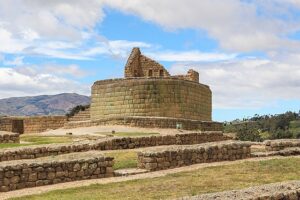
The “Temple of the Sun” of Ingapirca, Ecuador, 29 November 2014, photo by Bernard Gagnon, CCA-SA 3.0 Unported license.
Regardless of the shortcomings of Ecuador’s 2018 request, an agreement was signed in 2020 with a Designated List that included almost every known type of object made in Ecuador between 12,000 BCE and 1770 CE.[5] Following the State Department’s invariable policy of granting and renewing import restrictions regardless of merit, the 2020 import restrictions are likely to continue for another 5 years.
The Committee for Cultural Policy raised all these legal and procedural issues[6] in a submission to CPAC at the 2024 proposed renewal.[7]
Under the CPIA, import restrictions require that all four of the following criteria be met:
- The cultural patrimony of Ecuador is in jeopardy;
- The requesting nation has taken measures to protect its cultural patrimony;
- S. import restrictions, either alone or in concert with actions taken by other nations, would be of substantial benefit in deterring a serious situation of pillage; and
- Import restrictions would promote the interchange of cultural property among nations for scientific, cultural and educational purposes.

Sample burial in Ecological and Archaeological Park Rumipamba, Yumbo civilization. Photo by Pedro M. Martínez Corada, CCA-SA 4.0 International license.
A major question for U.S. policymakers is whether Ecuador is protecting its own cultural heritage. Is Ecuador is committed to safeguarding archaeological sites? The answer is no, not really.
Does Ecuador allow trade in archaeological objects and encourage private ownership of the same objects it wants to restrict U.S. access to? Here, the answer is a definitive ‘yes’; private ownership within Ecuador and even purchases of illicitly excavated material for Ecuadoran museums is widespread. The facts below establish that the terms of the CPIA are not met.[8]
Ecuador’s Remarkable History of Government Condoned Looting
Since its colonial beginnings, the government of Ecuador has had a long and fascinating history of legalized looting, primarily to fund its treasury and for taxation purposes. The work of Ecuadorian archaeologist Ernesto Salazar of the Universidad Católica del Ecuador provides plenty of evidence that the Ecuadorian government does not meet the requirements for an agreement under the CPIA – that for centuries, it has treated archaeological finds as simply another asset to be taxed.
Salazar, an archaeologist who abominates both looting and collecting, has nonetheless provided a frank portrait of Ecuador’s history of self-plunder of its archaeological resources in The looting of archaeological patrimony in Ecuador.[9] The history of Ecuador’s government’s failure to meet its own legal requirements for cultural property protection has been well documented in its courts, its encouragement of private ownership, and even its acquisition of artifacts for its state museums.

Metropolitan cathedral, Chapter house containing paintings of all bishops and archbishops of the Archdiocese of Quito since 1545.10 March 2016, photo by David Adam Kess, CCA-SA 4.0 International license.
Salazar dates the destruction and looting of archaeological sites for treasures to the Spanish colonial period and exposes how it continues “either officially or by tacit government approval” even today.[10] Salazar attributes much early archaeological destruction to a combined desire to gain riches and spread the Catholic religion. The historical archives of Ecuador show how Spaniards sought to destroy sites of pre-Columbian temples and shrines from the 16th century onward – and legalized excavations in archaeological sites in order to collect a 20% tax, called the “royal fifth,” on the emeralds, gold and silver found there.[11]
In 1563, the notorious and famously brutal looter Salazar de Villasante, knowing that shaft chambers were typical in the highlands, found masses of gold in one tomb, but refused to pay his co-workers or the tax, and a court case resulted after he almost killed the local chieftain. In the coastal regions, the fabulously wealthy La Tolita site was discovered in 1577 and was still being looted two hundred years later, when a Spanish priest reported on finding gold vessels in 1775. In the eighteenth century, fashionable Spanish-Ecuadorian ladies wore pre-Columbian gold jewelry. Salazar says that by then, the coastal regions had been explored and “the looting of archaeological sites was generalized.”
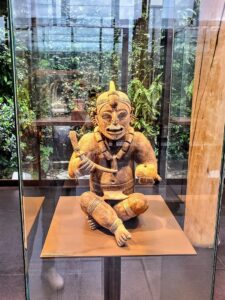
Casa del Alabado, photo by Natalia Lurie,
Salazar’s archival research shows how Indians, who did the work of digging, were abused by a large-scale highlands professional looter who was taken to court in 1653 for failing to pay their share of the finds. Another lawsuit was filed in 1724, this time against mestizo and Indian diggers who failed to turn over objects they discovered. Witnesses testified to finding a huge range of gold jewelry and even gold sandals in graves and sacred sites. Apparently, creating reproductions for the market goes as far back as illicit digging. A large gold vessel turned over to the court in the 1724 case turned out to be a fake and the maker and his selling price were identified.[12]
Salazar says that in the new Republican State, the situation worsened and there was even less interest in preserving the pre-Columbian archaeological record.[13] Under the Republic, the old ‘royal fifth’ was revived as a tax paid to support national education. It is known that a large high school in in the city of Cuenca was built with the proceeds of gold from the site of Chordeleg.[14]
Salazar writes:
“In 1852, the Serrano brothers settled in Chordeleg (southern highlands) to exploit gold mines located in the nearby cerro Fasayñan, a sacred mountain for the local Cañari indians. Fortunately, they didn’t have to leave for any mine, since, they found out, the marketplace of Chordeleg was full of pre-Columbian huacas. They simply found an enormous quantity of gold objects, the nature of which is poorly known, since the objects were melted almost on the spot (Serrano Iñiguez 1979). These fortunes of the Serrano brothers triggered a veritable gold fever throughout the whole province of Azuay. Dozens of sites were looted and thousands of pounds of gold objects were recovered, only to be melted away. A tomb easily yielded 50 to 100 pounds of gold.”[15]

Casa del Alabado, photo by Timothy Greiwe.
The late 19th century saw the emergence of foreign and domestic collectors in Ecuador. In 1870, the French art review Gazette des Beaux Arts described the collection of gold objects from Chordeleg of Eugène Thirion, the consul of Venezuela. The head of an Ecuadoran religious order sent a collection of artifacts to Chile for an exposition and offered a thousand more if they were needed. Three hundred objects were sent to the Musée Royal des Antiquités of Brussels by a Belgian consul in the 1870s. Edward Whimper, a British climber, collected artifacts during his mountaineering in Ecuador. At the end of the nineteenth century, they went through the Henry Christy collection to the British Museum. Early on, museums in Rome and Florence competed with European and American institutions to obtain the carved stone seats from the coastal Manteño culture and other Ecuadorian artifacts.[16]
As domestic Ecuadorian collections of archaeological materials grew, they became the foundations for both private and state museums. The collections of the Museum Nacional, originally the Museo del Banco Central, was established from the collection of a foreign resident. Salazar notes that Ecuador’s heritage laws state that all found archaeological objects and all objects still under the ground belong to the state. (A law that made all Ecuadoran cultural patrimony state property was passed in the 1940s.) Salazar says, however, that despite the prohibitions against trade in archaeological items, both state and private museums continued to buy artifacts from diggers, huaqueros.[17]
Salazar explains:
“An office of acquisitions was installed for the purchase of more objects brought to the museum by looters from all over the country. In the 80’s, it was something to watch, at the Quito office, on the stairs of a four story building, long lines of looters with bags or boxes containing artefacts for sale… In other words, the republic lets looters grab pre-Columbian antiquities, owned by the state, and subsequently buys them at the National Museum office, owned by the same state! … Eventually, this practice was abolished, but notwithstanding this, in 2004, the National Museum, and other local state agencies, bought quietly archaeological materials from the looters of Alacao site.”[18]
(Salazar notes that it was thought that the archaeological sites of Ecuador had all been plundered, but the huge Alacao finds in 2004 were a major surprise and were quickly bought up by both state museums and private collectors.)

Casa del Alabado, photo by Rosalind Carnes.
Salazar wrote in 2016 that the Ecuadoran state had recently begun to seek repatriation from foreign holders, established a patrimonial police group, and that its Customs was strengthened and workshops held to educate the public. However, he says that within Ecuador, “collecting has remained pretty intact. Anybody in Ecuador can have a collection: lawyers, painters, historians, etc., all of them oblivious to the fact that collectors are accomplices of an illicit action.”[19]
Today, Salazar says, Ecuadorian private collectors are regarded as sophisticated persons. The largest and best known of current Ecuadorian collectors is Daniel Jacques Klein Sussmann, who established a Fundación Tolita[20] to preserve and publicly exhibit his collection of some 5000 artifacts from Andean civilizations. This antiquities collection circulates through temporary displays in Casa del Alabado, a stunning private museum in a Spanish colonial home dating to 1671 in Quito that is one of the city’s most vaunted tourist destinations.[21]
Care and Management of Ecuador’s World Heritage sites.

Ceiling detail, Iglesia de El Carmen Alto Museum, Quito, historic center, 24 February 2016, photo by David Adam Kess, CCA-SA 4.0 International license.
UNESCO’s most recent reports on Ecuador’s five World Heritage sites, none of which are primarily archaeological, demonstrate a lack of urgency in government preservation efforts and a heightened dependence on foreign funding. [22] While the World Heritage Centre commended Ecuador in 2023 for finalization of a City of Quito management plan after many years, it expressed regret that it is still not approved by the government.[23] At the Galapagos Islands biological reserve, UNESCO reported that there was illegal, unreported and unregulated fishing and collection of aquatic resources, illegal harvesting of natural resources, unmitigated impact of excessive tourism, and inadequate and ineffective quarantine measures affecting biosecurity, in part due to inadequate implementation of Ecuador’s Special Law on Galápagos.[24]
In the Qhapaq Ñan Andean Road System, a multinational project with Chile, Colombia, and Peru, there were no reported issues with Ecuador.[25] However, at the Sangay National Park, UNESCO’s World Heritage Center reports poaching, illegal livestock grazing, encroachment along the Park’s perimeter, and unplanned road construction.[26] At the Santa Ana de los Ríos de Cuenca, a 16th century planned Spanish town inscribed in 1999, UNESCO notes that Ecuador’s Ministry for Heritage Coordination financed repair work for the roof of the Convent of All Saints and maintenance and conservation of the Ancient Seminary San Louis.[27] No other significant conservation activity is documented on the UNESCO website.
Recent discoveries in Ecuador through lidar technology.
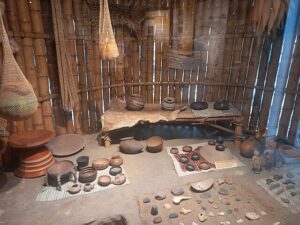
Display: Arqueologia en Ecuador, 12 August 2023, photo by Ceibos, CCA-SA 4.0 International license.
Dramatic archaeological discoveries have been made since 2015 in Ecuador utilizing airborne lidar scanning technology.[28] A team of researchers from France, Germany, Ecuador and Puerto Rico, led by Stéphen Rostain of France’s National Centre for Scientific Research, have scanned a 600-square kilometer section of the Upano Valley in southern Ecuador, revealing a network of about 6,000 mounds under the tree canopy.[29] The mounds are the remains of homes and plazas of some 15 ancient rural communities connected by the remains of roads. Archaeologists believe that these Kilamope and Upano remains are from farming settlements dating between 500 BCE and 600 CE. A later Huapula culture also lived in the same region between 800 and 1200 CE.
Archaeological work at the sites shows that these farming communities’ buildings were constructed of earth. Southern Ecuador does not contain the sort of riches looted for centuries from sites in northern Ecuador. The few objects that have been found are simple ceramic vessels. Many organic materials would have disintegrated over time and this region does not have the stone available for carving vessels or construction of stele and lintels that were found in other Mesoamerican and Peruvian regions.
Ecuadorian heritage initiatives are led and paid for by the U.S. State Department, not Ecuador’s government.
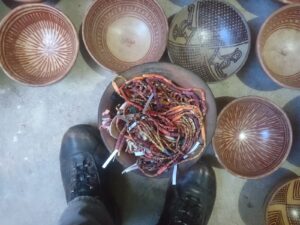
Decorated ceramic bowls associated with Pasto culture. Inside one are bracelets and necklaces made with Spondylus mussels. Department of Nariño in southern Colombia and Carchi province, northern Ecuador, Integration Period (500 AD to 1532 AD). 6 March 2018, photo by Tupak Amarulshkay, CCA-SA 4.0 International license.
Development of law enforcement for cultural heritage in Ecuador appears to be sponsored chiefly by the U.S. Department of State’s Cultural Heritage Center and its Cultural Antiquities Task Force (CATF). In February 2023, CATF led a week-long workshop in Ecuador sharing “best practices on investigating cultural property crime, handling and collecting evidence, paths to repatriation, and the importance of preserving heritage.” [30]
There also appears to be a direct link between offers of U.S. funding and activities that support requests for US-Ecuador cultural agreements. A notice published by the Department of State announced grant funding from $10,000 to $500,000 available for year 2024 from the Ambassador’s Fund for Cultural Preservation in Ecuador, stating:
“Additionally, for this year, priority will be given to projects presented that promote security in the country and the region, such as projects to improve security for museums or archaeological sites, or to protect collections, or the involvement of local communities in the protection of cultural heritage, among others. and that meet one or more of the following criteria:
-
Direct support for US bilateral treaties or agreements.
-
Direct support to the objectives of the United States Embassy in Ecuador.
-
Disaster risk reduction for cultural heritage in seismically active and other disaster-prone areas and/or recovery of cultural heritage after a disaster.
-
Complement other programs of the United States Department of State’s Bureau of Educational and Cultural Affairs (ECA) or public diplomacy.”[31]
It appears that in Ecuador – and in other countries where funding goes to projects that directly contribute to collecting data and documentation supporting MOUs, the State Department’ Cultural Heritage Center is not a neutral administrator of the law. In fact, Cultural Heritage Bureau employees aggressively advocate for heritage agreements, sometimes cutting corners around the CPIA.[32]
Conclusion
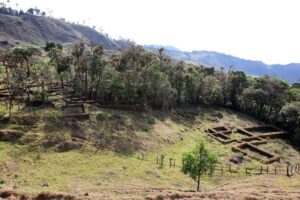
Archaeological site at Yacuviñay, 6 July 2013, photo by Hermel Pineda, CCA-SA 3.0 Unported license.
The CPIA is a good law that allows reasonable restrictions on imports to prevent the looting of archaeological sites. Instead of following the guidelines established by Congress, activists at the Bureau of Education and Cultural Affairs work to perpetually renew comprehensive import restrictions on virtually every kind of object from more than thirty nations. Regrettably, the State Department’s 2020 decision to block Ecuadorian art and artifacts was not based on the requirements and plain language of the CPIA statute. Nor is the current proposal to renew the 2020 Ecuador agreement until 2029.
The Committee for Cultural Policy has consistently stated that the U.S. State Department and its Cultural Property Advisory Committee’s first concern in every MOU or renewal should be to act in compliance with U.S. law. The CPAC committee can legally recommend extending the MOU with Ecuador only when Ecuadorian authorities demonstrate compliance with all four of the criteria set under the CPIA. This, the Government of Ecuador has failed to do.
Instead, the State Department itself generates requests from art source countries, then facilitates their recommendation by minimizing and even disregarding the statutory requirements and severely limiting public comment.[33] The Ecuador Request, like almost all others now heard by CPAC, is another example of a cultural “mission creep” that has steadily expanded the kinds of art and artifacts embargoed from entry into the United States to the detriment of U.S. museums and the public interest.
[1] 2018 Public Summary Request by the Government of the Republic of Ecuador to the Government of the United States of America to Impose Import Restrictions to Protect its Cultural Patrimony under Article 9 of the 1970 UNESCO Convention; https://eca.state.gov/files/bureau/ecuadorrequest2018_publicsummary_04.05.2018.pdf. The Public Summary states that there is looting in numerous locations without actually documenting any specific instances. It says objects are stolen from churches (already illegal under U.S. law without an agreement under the CPIA) noting only a wooden statue of Christ taken in 1999 and an inkwell taken in 2011. It refers to 47 traveling exhibitions since 2004, but none to the United States.
[2] U.S. Sen. Rpt. 97-564 (September 21, 1982), 6.
[3] The 2019 import restrictions published in the Federal Register state: “The Agreement includes, but is not limited to [our emphasis] the categories of objects described in the designated list set forth below. Importation of material on this list is restricted unless the material is accompanied by documentation certifying that the material left Ecuador legally and not in violation of the export laws of Ecuador.” https://www.federalregister.gov/documents/2024/05/22/2024-11177/import-restrictions-imposed-on-archaeological-and-ethnological-material-from-ecuador-correction. The provision allowing import after tens years outside of the originating country ensures that the restrictions apply to recently looted items, not objects long in circulation. 19 U.S.C. § 2606(b)(2)(A).
[4] The definition of ethnological material under CPIA is: “[I] the product of a tribal or nonindustrial society, and [II] important to the cultural heritage of a people because of its distinctive characteristics, comparative rarity, or its contribution to the knowledge of the origins, development, or history of that people.” 19 U.S.C. 2601(2)(C)(ii).
[5] Import Restrictions Imposed on Archaeological and Ethnological Material From Ecuador, Federal Register / Vol. 85, No. 31 / Friday, February 14, 2020, 8389-8395, https://www.govinfo.gov/content/pkg/FR-2020-02-14/pdf/2020-03118.pdf.
[6] The original 2018 Ecuador Request was made public only nine days before public comment was due and only a few weeks before the Cultural Property Advisory Committee (CPAC) was scheduled to hear public commentary on the request, making it impossible for U.S. museum groups to canvas their members in order to reply.
[7] Committee for Cultural Policy and Global Heritage Alliance Written Testimony submitted to Cultural Property Advisory Committee, Bureau of Educational and Cultural Affairs, U.S. Department of State, on the Proposed Extension of the 2020 Memorandum of Understanding Between the United States of America and the Republic of Ecuador Submitted May 24, 2024 for Hearing June 4, 2024, 2024-06-04 CCP Testimony to CPAC on Ecuador
[8] In recommending the signing of an MOU with Ecuador, the CPAC committee and the administration at State responsible for making recommendations to the President failed to adhere to the criteria set forth in these Four Determinations. Under the CPIA, all four criteria must be met for an MOU to be signed with a requesting country. 19 U.S.C. § 2602 (a)(1).
[9] Ernesto Salazar, “The looting of archaeological patrimony in Ecuador”, Sharon, Gonen and Avraham Ronen, Eds. Proceedings of the 20th (1) Congress Suyanggae and Her Neighbors, Haifa, Israel June 2015, 99-107.
[10] Salazar, Id. at 99.
[11] Id. at 101(as reported by Pedro Arevalo in 1600).
[12] Id.
[13] Id.
[14] Id. at 105.
[15] Id. at 101.
[16] Id.
[17] While most diggers are mixed race Meztizos, Salazar states that Indians who are less tied to tradition and to respect for ancestors also looted artifacts. An informer from La Tolita told him that after so many years, “these dead don’t ask for anything.” Salazar says that while a very few huaqueros have metal detectors, most rely on a divining stick and their intimate knowledge of the ground. Salazar, Id. at 103.
[18] Salazar, Id. at 106.
[19] Salazar, Id. at 106.
[20] Fundación Tolita, https://www.edina.com.ec/3757464/17/31/3847731/fundacion-tolita//quito
[21] Museo Casa del Alabado, https://alabado.org/inicio/
[22] UNESCO World Heritage Convention, “Ecuador,” https://whc.unesco.org/en/statesparties/ec.
[23] City of Quito (historic city), inscribed 1978, previously listed as a World Heritage site in Danger. Notes with satisfaction the stabilization achieved in the underground metro development in the Historic Centre of Quito. The report notes 16 approved requests for international assistance. Funding provided $391,800. Additional foreign funding grants for metro $100,000.
[24] Galapagos Islands (biological reserve), inscribed 1978, 26 approved requests for international assistance. Funding provided $627,825. Additional special funding $3.5 million for introduced species Trust Fund. World Heritage Centre noted progress on fishing monitoring, but lack of government action on other current harms. For terms of the Special Law on Galapagos, see https://web.mit.edu/12.000/www/m2008/teams/sebasc/leyespecial.htm.
[25] There were, however, serious concerns over the impact of a new Cuzco international airport that plans to bring large numbers of tourists to travel the ancient road system. Qhapaq Ñan Andean Road System funding: USD 1,012,810 during the period 2003-2011 under the Spanish Funds-in-Trust; USD 450,000 for management. $75,000 for risk analysis and application for World Heritage status.
[26] Sangay National Park, inscribed 1983. UNESCO funding $80,000, World Heritage funding $58,500.
[27] At Santa Ana de los Ríos de Cuenca, UNESCO funded $15,000 in assistance for its designation as World Heritage site.
[28] Garth Harris, Plazas and Pottery: oldest Amazonian cities uncovered in major archaeological discovery in Ecuador, The Art Newspaper, Jan 15, 2024, See also: Alan Yuhas and Jesus Jimenez, Remnants of Sprawling Ancient Cities Are Found in the Amazon, NYT, Jan 23, 2024, https://www.nytimes.com/2024/01/23/science/ecuador-amazon-cities-discovery.html
[29] Amanda Heidt, An ancient, massive urban complex has been found in the Ecuadorian Amazon, Science News, Jan 11, 2024, https://www.sciencenews.org/article/ancient-urban-complex-ecuador-amazon-laser.
[30] “Cultural Antiquities Task Force Organizes Law Enforcement Workshops in Cambodia and Ecuador,” April 12, 2023, Bureau of Educational and Cultural Affairs, Department of State, https://eca.state.gov/highlight/cultural-antiquities-task-force-organizes-law-enforcement-workshops-cambodia-and-ecuador.
[31] U.S. Ambassador’s Fund for the Preservation of Cultural Heritage (Ecuador), https://www2.fundsforngos.org/latest-funds-for-ngos/u-s-ambassadors-fund-for-the-preservation-of-cultural-heritage-ecuador/, last visited 5/20/2024.
[32] “U.S. Signs MOU with Yemen. This Time, No Testimony Allowed,” Cultural Property News, September 7, 2023, https://culturalpropertynews.org/u-s-signs-mou-with-yemen-this-time-no-testimony-allowed/.
[33] CPAC’s public hearings on requests and renewals of MOUs once allowed interested parties to appear in person and discussion lasted three or four hours on a single country request – each country having its own full day of public hearing. The scope of the information provided to CPAC is now limited almost entirely to “facts” supplied by the State Department’s Education and Cultural Affairs section, which oversees CPAC, and private information sessions supportive of MOUs. In recent years only one hour has been allotted for public comment per CPAC meeting, no matter how many requests are being heard or how complex the issues. Speakers are allotted only 3-5 minutes within the one-hour period.
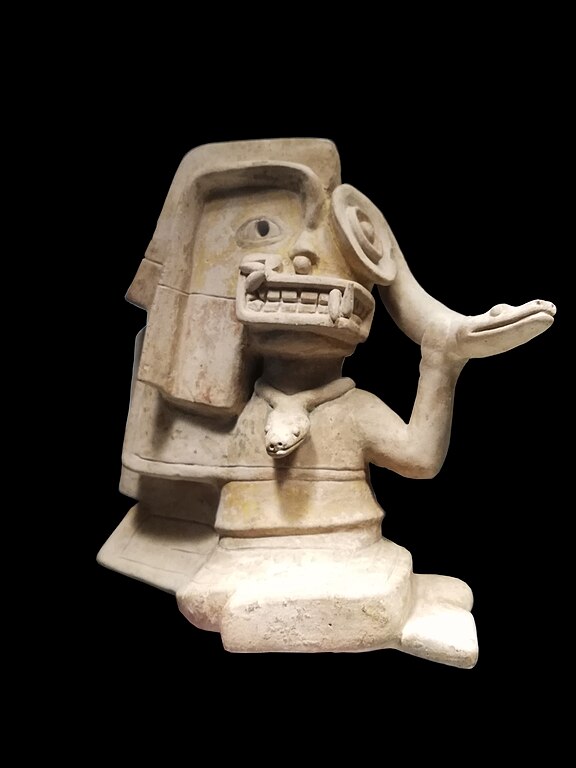 Sculpture of Tumaco culture, Tolita, 5 January 2022, photo Simon Luzuriaga, CCA 3.0 Unported license.
Sculpture of Tumaco culture, Tolita, 5 January 2022, photo Simon Luzuriaga, CCA 3.0 Unported license. 

